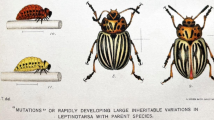Summary
Computer simulation was used to compare Hallauer's cyclic single cross selection (CSCS) with reciprocal recurrent selection (RRS). Three epistatic and three non-epistatic models with 60 loci determining a single character provided the genetic base. The rate of advance over seven cycles was always greater for CSCS than for RRS on either a cycle or generation basis. No genetic conditions were found where CSCS failed to respond. The advantages of CSCS increases as the proportion of non-additive genetic variance increases. Genetic advance of the hybrid population was shown to result from the joint effects of an average change in gene frequency and complementary effects (nicking) of selection. Nicking effects accounted for most of the advance for some starting conditions. RRS generally had higher selection limits with no epistasis or low gene frequency of the dominant allele. CSCS generally had higher limits with epistasis or high frequency of the dominant allele. We suggested that CSCS begin with divergent genetic populations and strong selection intensity for three cycles. Final selection of superior single crosses was indicated when the lines were completely inbred.
Similar content being viewed by others
Literature
Comstock, R. E., Robinson, H. F., Harvey, P. H.: A breeding procedure designed to make maximum use of both general and specific combining ability. Agron. J. 41, 360–367 (1949).
Cockerham, C. C.: Implications of genetic variances in a hybrid breeding program. Crop Sci. 1, 47–52 (1961).
Cress, C. E.: Reciprocal recurrent selection and modifications in simulated populations. Crop Sci. 7, 561–567 (1967).
Gill, J. L.: Effects of finite size on selection advance in simulated genetic populations. Aust. Jour, of Biological Sci. 18, 599–617 (1965).
Hallauer, A. R.: Development of single-cross hybrids from two-eared maize populations. Crop Sci. 7, 192–195 (1967a).
Hallauer, A. R.: Performance of single-cross hybrids from two-ear varieties. Ann. Hybrid Corn Industry Res. Conf. Proc. 22, 74–81 (1967b).
Harter, H. L.: Expected values of normal order statistics. Biometrika 48, 151–165 (1961).
Russell, W. A., Eberhart, S. A.: Effects of three gene loci in the inheritance of quantitative characters in maize. Crop Sci. 10, 165–169 (1970).
Sprague, G. F., Thomas, W. I.: Further evidence of epistasis in single and threeway cross yields of maize (Zea mays L.). Crop Sci. 7, 355–356 (1967).
Stuber, C. W., Moll, R. H.: Epistasis in maize (Zea mays L.). I. F1 hybrids and their S1 progeny. Crop Sci. 9, 124–127 (1969).
Author information
Authors and Affiliations
Additional information
Communicated by R. W. Allard
Michigan Agricultural Experiment Station paper no. 5712. Supported in part by Grant GB6646 of the National Science Foundation and the Government of Iran. Part of a thesis submitted by the senior author in partial fulfillment of the requirements for the Ph.D. degree.
Rights and permissions
About this article
Cite this article
Ehdaie, B., Cress, C.E. Simulation of cyclic single cross selection. Theoret. Appl. Genetics 43, 374–380 (1973). https://doi.org/10.1007/BF00278175
Received:
Issue Date:
DOI: https://doi.org/10.1007/BF00278175




